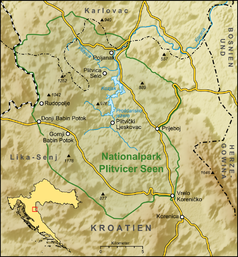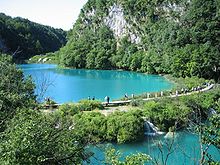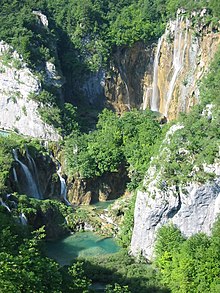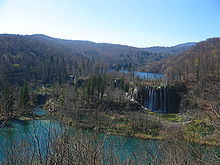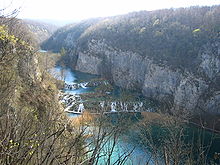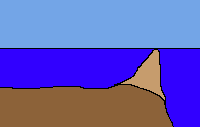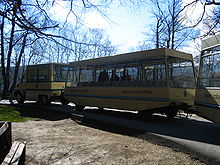Plitvice Lakes National Park
| Plitvice Lakes National Park | |
|---|---|
|
UNESCO world heritage |
|

|
|
| National territory: |
|
| Type: | nature |
| Criteria : | (vii) (viii) (ix) |
| Surface: | 29,630.77 hectares |
| Reference No .: | 98bis |
| UNESCO region : | Europe and North America |
| History of enrollment | |
| Enrollment: | 1979 ( session 3 ) |
| Extension: | 2000 |
| Red list : | 1992-1997 |
| Plitvice Lakes National Park | ||
|---|---|---|
|
|
||
| Location: | Karlovac , Lika-Senj , Croatia | |
| Specialty: | Natural formation of travertine barriers , many cascades and waterfalls, particularly pure water, rare animal and plant species, primeval forest area, karst phenomena, UNESCO world natural heritage | |
| Next city: | Korenica and Slunj | |
| Surface: | 296.85 km² | |
| Founding: | April 8, 1949 | |
| Visitors: | 946,825 (2008) | |
| Address: |
www.np-plitvicka-jezera.hr HR-53231 Plitvička jezera Tel. +385 (0) 53 751 015 |
|
|
|
||
|
|
||
The Plitvice Lakes National Park [ ˈplitʋitsɛr ˈzeːn ] ( Croatian Nacionalni park Plitvička jezera , colloquially Plitvice , also Plitvice Lakes ) is the largest national park in Croatia and also the oldest national park in Southeast Europe . It was founded in 1949 and is located in the hilly karst area of central Croatia not far from the border with Bosnia and Herzegovina , directly on an important north-south road connection that connects the interior of Croatia with the Mediterranean coastal region. The protected national park area covers 296.85 square kilometers. Of this amount, about 90 percent to the County of Lika-Senj and about 10 percent to the county Karlovac . The Plitvice Lakes were included in the UNESCO World Heritage List in 1979 as one of the first natural monuments in the world . The national park administration counts around one million visitors annually. There is a fee to enter. Strict rules of conduct apply.
Characteristics
The national park is world-famous for its cascading lakes, 16 of which are currently visible on the surface. These were formed by the confluence of several small rivers and by underground karst tributaries. The lakes arranged along a flow direction are separated from each other by natural barriers, a characteristic of unique natural processes. The particularly unstable travertine barriers are created by the interplay of flowing water, air and vegetation.
The different climatic influences, as well as the great difference in altitude within the protected area, result in a particularly diverse flora and fauna. Many endemic species can be found in the national park area . All animal species that were already at home before humans appeared in the protected area continue to exist.
Notoriety
The name Plitvice was first mentioned in writing in 1777 by Dominik Vukasović, the parish priest of Otočac . The Plitvice Lakes owe their name to the natural phenomenon that created the lakes. Nature initially formed shallow basins (Croatian: pličina or plitvak , note plitko means shallow ) and finally lakes, due to the fact that the water nestled into the landscape or was dammed higher and higher by travertine barriers.
Some scientists attribute the name to the Plitvica river , which only flows into the lakes at the lower end. A nearby town bears the same name. The water masses of the Plitvice Lakes continue their way as the Korana River in a northerly direction.
The park became famous in German-speaking countries, among other things, through the Karl May films from the 1960s. Some lake and waterfall scenes were filmed in this national park.
location
reachability
The Plitvice Lakes were formed in the deepening between the Mala Kapela mountains in the west and Plješevica in the east, in the middle of the Dinaric mountain range. The Plitvice Lakes National Park is located on the national road D1 Zagreb – Split, between Slunj and Korenica , not far from the border with Bosnia and Herzegovina . Other larger towns in the surrounding area are Ogulin , Rakovica , Otočac , Gospić , and Bihać on the Bosnian side.
The national park is about 55 kilometers as the crow flies from the Adriatic coast. From the coast, the Plitvice Lakes can be reached after about 60 kilometers by road from Senj . After crossing the Velebit Mountains, you enter the karst area of Central Croatia or the Lika with numerous poljes (e.g. the Gacko polje with the Gacka river , which is known for its water purity and seclusion).
The A1 Zagreb – Split motorway runs around 50 kilometers west of the national park. The Plitvice Lakes can be reached via the exits Karlovac in the north, Otočac in the west or Gornja Ploča in the south.
The nearest airports are Zadar, Zagreb and Rijeka, the nearest train stations would be Josipdol and Plaški , from which there are no bus connections to the lakes. The most comfortable way to get to the Plitvice Lakes is by public transport from Zagreb, Karlovac, Zadar or Split.
structure
The national park area of the Plitvice Lakes extends over two political sub-units, so-called counties . The national park itself is subject to national administration. Of the total area of the national park, which is 296.85 square kilometers, 90.7 percent is in the Lika-Senj County and 9.3 percent in the Karlovac County. The total area of the lakes is 2 square kilometers. Almost 80 percent of this is accounted for by the two largest lakes, Prošćansko jezero and Lake Kozjak. These lakes are also the deepest lakes, each 37 and 47 meters deep. Quiet and environmentally friendly electric boats operate on the Kozjak. None of the other lakes are deeper than 25 meters. The difference in altitude between the lakes is 133 meters.
The total of 16 above-ground lakes are divided into the twelve Upper Lakes ( Gornja jezera ) and the four Lower Lakes ( Donja jezera ).
| No. | lake | Height above d. M. | Area (ha) | Depth (m) | group |
|---|---|---|---|---|---|
| 1 | Prošćansko jezero | 636 | 68.0 | 37 | Upper lakes |
| 2 | Ciginovac | 625 | 7.5 | 11 | Upper lakes |
| 3 | Okrugljak | 613 | 4.1 | 15th | Upper lakes |
| 4th | Batinovac | 610 | 1.5 | 6th | Upper lakes |
| 5 | Veliko jezero | 607 | 1.5 | 8th | Upper lakes |
| 6th | Malo jezero | 605 | 2.0 | 10 | Upper lakes |
| 7th | Vir | 599 | 0.6 | 5 | Upper lakes |
| 8th | Galovac | 585 | 12.5 | 25th | Upper lakes |
| 9 | Milinovo jezero | 576 | 1.0 | 1 | Upper lakes |
| 10 | Gradinsko jezero | 553 | 8.1 | 10 | Upper lakes |
| 11 | Buk | 545 | 0.1 | 2 | Upper lakes |
| 12 | Kozjak | 535 | 81.5 | 47 | Upper lakes |
| 13 | Milanovac | 523 | 3.2 | 19th | Lower lakes |
| 14th | Gavanovac | 519 | 1.0 | 10 | Lower lakes |
| 15th | Kaluđerovac | 505 | 2.1 | 13 | Lower lakes |
| 16 | Novakovića brod | 503 | 0.4 | 5 | Lower lakes |
| Plitvice Lakes | 217.0 |
The tallest waterfalls include the large waterfall (Croatian: Veliki slap ) in the lowest part of the lakes, over which the Plitvica river plunges, and the Galovački buk on the upper lakes. The big waterfall is also the largest waterfall in Croatia.
| waterfall | height |
|---|---|
| Veliki slap (big waterfall) | 78 m |
| Galovački buk (Galovac waterfall) | 25 m |
There are 19 smaller settlements in the national park area. Together they form the municipality of Plitvička Jezera (German: Plitvice Lakes ), whose headquarters are located in Korenica and belongs to the Lika-Senj County.
The area is always considered to be part of the historical Lika and Kordun regions . During the Turkish wars it was part of the military frontier , which was directly subordinate to the Imperial-Habsburg Ministry of War.
Topography and geology
terrain
The special location of the Plitvice Lakes and the peculiarities of the prevailing climate are largely responsible for the natural phenomena occurring in the national park, as well as for the biodiversity in this area. Despite the immediate proximity to the Mediterranean climate region, the Plitvice Lakes have a moderate mountain climate. This is due to the Velebit mountain range, which forms a strict climatic dividing line and separates the coastal area from the Lika high plateau. For centuries there have been legends about this imposing mountain range.
The nature of the terrain is of great importance for the water supply and the biodiversity in the area. The Plitvice Lakes are surrounded by numerous mountains. The national park area is bordered to the west by the Mala Kapela mountain range and to the east by the Plješevica mountains, which also form the border with Bosnia. The wooded mountain slopes serve as water reservoirs and are also a refuge for many animal species. The large difference in height in a narrow space between the heights in the south and the Korana river in the north is another criterion for the biodiversity in this region. Over the entire area of the national park, the difference in altitude is 912 meters (the highest point, the Seliški vrh , is 1279, the lowest point 367 meters above sea level at the bridge over the Korana).
Tributaries
The Plitvice Lakes are formed in the south by the confluence of the two tributaries Bijela Rijeka (German White River ) and Crna Rijeka (German Black River ). These arise not far from the village of Plitvički Ljeskovac , where they unite under the bridge. The water masses from this point up to reaching the first Plitvice lake are called Matica (German roughly tribe or origin ). At the Liman Bay (also called Limun ), part of the Prošćansko jezero , another, nameless stream flows into it. This is nourished by permanent springs, but the amount of water is variable. Water masses also enter the lake via occasionally water-bearing brooks on the west side of Prošćansko jezero .
The Plitvica river flows into the end of the Plitvice chain of lakes (in the north) over the Great Waterfall . This place is called Sastavci (German: composition or confluence ). The water masses of the Plitvice Lakes and the Plitvica River form the Korana River .
Underground nature
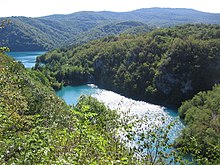
The subsoil of the Plitvice Lakes is different. The entire area of the national park can, however, be assigned to the south-eastern European karst area . Typical for the karst area is brittle or holey rock, mostly limestone or dolomite, which has a wide variety of geomorphological forms on the surface ( sinkhole , polje , uvala , ponor , etc.).
The analysis of the underground water courses in this area will be a particularly interesting field of activity for speleologists in the future . At first glance, the karst area is characterized by its water scarcity, that is, there is a lack of springs and rivers. However, this is only the case on the surface of the earth. A considerable part of the natural spectacles takes place inside the rock, where there is also sufficient water.
Due to the peculiarities of the karst rock, the rivers seep into the rock and pave their way there. Where a river meets harder rock, the water masses of the karst rivers (Croatian: rijeka ponornica ) come to the surface again, which can also be observed in the Plitvice Lakes.
From the Pleistocene onwards, the travertine sediments formed in sinkholes or depressions between the surrounding mountains. Roughly speaking, there are two rock formations at the Plitvice Lakes. The upper lakes in the south lie in a zone with predominantly dolomite rock, the lower lakes in the north predominantly in a zone with limestone. The texture of dolomite is somewhat harder than limestone. Although it is easily fragile due to physical impact, it is characterized by low water permeability. In contrast, limestone is somewhat more compact and massive, but has a higher water solubility.
If you look at the Plitvice Lakes from the air, you can see clear differences between the upper and lower lakes. While several smaller lakes have formed parallel to each other in the upper ones and the water course is much shallower, the lower lakes, so to speak, dig into the rock. The number of lower lakes is fewer. They practically form a canyon that continues as the Korana River.
climate

The average annual rainfall on the Plitvice Lakes is 1500 millimeters, with heavy rains most common in spring and autumn. The average relative humidity is 81.8%. In January the average temperature is 2.2 ° C. In the summer months of July and August it rises to 17.4 ° C. Overall, the average annual temperature is 7.9 ° C. Snow is from November to the end of March. The lakes are mostly covered by a layer of ice in December and January.
The water temperature at the source rivers is usually below 10 ° C. In the rivers and lakes, the water warms up to 20 ° C. A measurement from July 7, 1954 can be used as an example of a wide variety of water temperatures: a temperature of 18.9 ° C was measured in Lake Kozjak at a depth of 4 meters, 5 ° C at a depth of 20 meters and 44 meters Depth, practically at the bottom of the lake, even only 4.1 ° C.
Rock loosening and formation
The lake landscape of the Plitvice Lakes in the middle of the karst landscape owes its origin to the deposition of lime , which is abundant in karst waters. These deposits are called limestone tuff or travertine (both are called sedra or tuf in Croatian , along with many other names).
The peculiarity of the Plitvice Lakes is that they do not represent separate standing water. The respective lakes have always been viewed as a composite system. Due to the constant changes, analyzes of individual lakes are not necessarily effective. The masses of water that flow into the lakes above or below ground and flow on as the Korana River at the end change the appearance of the lakes and the surrounding landscape anew. On the one hand, tufa is partially washed away, on the other hand, new deposits are constantly forming. This creates new waterfalls while old ones dry up. Nature also constantly adapts to new circumstances. Overall, the lake complex is a very sensitive and unstable ecosystem.
Weathering processes

The actual phenomena of the Plitvice Lakes began to form relatively late in the geological time frame. For the very complex processes of lime dissolution and deposition, certain basic climatic conditions are necessary. These have only existed since the end of the Ice Age 12,000–15,000 years ago, which resulted in radiocarbon dating of the travertine.
Apart from weather and temperature factors, water quality as well as natural factors are of decisive importance for the development of the natural phenomena that prevail in the Plitvice Lakes. The karst rivers dissolve lime ( calcite ) as they flow through the rock and thus enrich themselves. The degree of calcite saturation of the source rivers is therefore very high.
The solubility of the limestone is based on the carbonic acid weathering. Carbonic acid (H 2 CO 3 ) is formed in nature by dissolving the carbon dioxide (CO 2 ) contained in the air in rainwater (H 2 O). Limestone or dolomite (CaMg (CO 3 ) 2 ) consists mainly of the poorly water-soluble calcite (CaCO 3 ). Calcite is dissolved by the carbonic acid in the water and calcium hydrogen carbonate Ca (HCO 3 ) 2 is formed . This can be illustrated using the following formulas:
| H 2 O + CO 2 ↔ H 2 CO 3 ↔ H + + HCO 3 - ↔ 2 H + + CO 3 2− |
| CaCO 3 + H 2 CO 3 → Ca (HCO 3 ) 2 |
| CaCO 3 + H + + HCO 3 - ↔ Ca 2+ + 2 HCO 3 - ↔ Ca (HCO 3 ) 2 |
The amount of calcium hydrogen carbonate (also called calcium bicarbonate ) dissolved in water depends on the amount of carbon dioxide dissolved in water. In general, the colder the water, the higher the proportion of dissolved calcium hydrogen carbonate. Depending on the weathering conditions, researchers have determined lime dissolution rates of 0.01 to 4 millimeters per year. (Rainwater can remove about 1 m³ of karst rock in 10,000 years.)
Sedimentation processes
The mechanical and chemical dissolution processes mentioned above are a widely occurring natural phenomenon. It is characteristic of the Plitvice Lakes, however, that the lime bound in the water begins to be deposited in certain places, and even this only in a certain area. In contrast to other similar phenomena in the world, lime deposits and travertine formation on the Plitvice Lakes take place along a certain direction of flow and in various forms (including fluvial sedimentation ).
A worldwide specialty are the natural and here especially the vegetable influencing factors. The rushing river water always forms new barriers when it overflows natural thresholds, which initially slow down the water on several levels connected to waterfalls and ultimately dammed it. There is an interaction between water, air, rock and vegetation. The masses of water churned up at the barriers create ever more imposing waterfalls that grow in height.
About 30 kilometers north of the lakes, at the confluence of the Korana and Slunjčica rivers in the middle of the small town of Slunj, phenomena very similar to those of the Plitvice Lakes formed. The district of Rastoke is therefore also known as "the small Plitvice Lakes".
Basic requirements for sediment formation

The most striking feature of continuous sedimentation processes in the area of the Plitvice Lakes are measurements of the carbon dioxide content of the water. It is about twenty times higher at the sources than that in the atmosphere. The proportion of carbon dioxide decreases with increasing progress. The Plitvica River even loses up to 97% of its original carbon dioxide content over the entire course of the river.
The lime content of the water only precipitates under certain temperature conditions (only from 14 ° C), through water heating and evaporation or through some other loss of carbon dioxide, for example with the help of aquatic plants or mosses. Since the sedimentation process can only take place in a warm, humid climate, such phenomena have only appeared since the end of the Ice Age. Since then, a layer of hardened tufa, also known as travertine, has formed on the existing subsoil.
The area of a river in which travertine is formed is called the precipitation area. For example, the Korana, calculated from its source rivers, only forms travertine along the first 10 to 15 kilometers, even if the conditions in terms of pH values would be favorable. In Lake Kozjak, a constant annual sedimentation of 0.8 millimeters of the subsurface over the last 3000 years was found. Barriers can increase in height by 13.5 millimeters every year. The travertine formation processes thus outperform the erosion processes that would destroy the sensitive sea barriers. The age of the travertine on the lake bed and on the barriers is estimated to be around 6,000 to 7,000 years. An analysis of the older barriers indicates their formation about 90,000 to 130,000 years ago during the Eem warm period (Riss / Würm interglacial) in the Pleistocene .
Lime precipitation does not occur directly at the sources of the tributaries of the Plitvice Lakes. In order for the water to precipitate carbonate of lime (calcium carbonate), the water must reach a certain degree of mineral saturation. The degree of saturation at the springs is around 1. For calcium carbonate to precipitate, the degree of saturation must exceed 3. At the same time, the pH of the water must be above 8.0 (slightly basic).
Thresholds become barriers


The formation of travertine barriers occurs when calcium-rich water flows in thin layers over a base and is whirled up. It thus forms a large surface area and emits more carbon dioxide (CO 2 ). Small crystals are deposited and lime sinter , also called tufa (CaCO 3 ), is formed. Barriers form, especially on the abundant mosses.
Over time, growing barriers and rising water levels can inundate older barriers. Around 400 years ago, an older barrier divided Lake Kozjak in half. This barrier is now pretty much in the middle of the lake, about five meters below the lake surface.
Influence of plants
In the unique lake landscape of the Plitvice Lakes, mosses , algae and aquatic plants play an important role in the formation process of travertine barriers . These contribute to the special biodynamics at the barriers.
Until the beginning of the 21st century, it was assumed that the plants took carbon dioxide from the water for photosynthesis and that in return they released oxygen, which should lead to the splitting and deposition of hydrogen carbonate ( phytogenesis ). Ivo Pevalek was in charge of this research . He also deserves the honor that the Plitvice Lakes were ultimately placed under protection. Recent research has shown that plants are not primarily responsible for the precipitation of calcite from running water, but they do have an indirect effect on travertine formation. The decisive factor is rather the slowing down, aeration and atomization of the water. Mosses are only a substrate , i.e. a base, for sedimentation.
The photosynthetic activity of algae or moss in interaction with the water can, however, have a favorable effect on the crystallization of the deposits due to the consumption of carbon dioxide . Millions of microscopic bacteria and algae that thrive on such plants are particularly notable for this. They secrete mucus on the surface of which crystals adhere. The most important of these plants are mosses of the genus Cratoneuron commutatum and Bryum pseudotriquetrum , in addition to which other mosses of the genera Eucladium and Philonotis can be found on the Plitvice Lakes. This can be seen very clearly from the fact that the young shoots are still soft and green, while older plants have a yellowish color and are covered with a firm but fragile layer. The mosses not only promote the formation of tufa barriers, they even become part of these barriers as they are covered by ever newer layers. Old travertine is full of petrified algae or moss. This type of tufa, which is typical for the Plitvice Lakes, is called phytogenic tufa .
Disruptive influences on travertine formation
As much as plants have a decisive influence on the formation of travertine, an excessively high concentration of organic substances in the water has an inhibiting effect on it. Too much growth on the barriers (this has been systematically removed for some time) counteracts the precipitation of minerals. The purity of the water is primarily decisive for the formation of travertine. From a water analysis point of view, the water of the tributaries to the Plitvice Lakes is extremely pure. The dissolved organically bound carbon value (DOC) of the water at the beginning of the upper lakes hardly exceeds 2.5 mg / L. The values at the lower lakes show higher organic concentrations (5.15 mg / L). Other Croatian karst rivers show similarly low readings near their exit points.
The unguided tourism in the 20th century and the pollution by sewage from hotels or agriculture in the vicinity left harmful traces. This led to an increasing eutrophication of the lakes (an increased concentration of organic substances in the water). The protection of this very sensitive area from excessive human influences to enable the undisturbed and sustainable formation of travertine is therefore of immense importance. There has been a strict bathing ban on the lakes since 2006. Until then, swimming was permitted on Lake Kozjak.
Differentiation of rock types
| Rauhwacke | Porous rock that has been attacked by external influences, e.g. rainwater (limestone or dolomite) |
| Tufa | Deposits of minerals from the water. They usually solidify on mosses or on the subsoil of the lakes. Deposits arise through centuries-old sedimentation processes. New layers are added every year. |
| Travertine | Solidified tufa. Older, hardened sediments. The porous rock is sensitive and cannot withstand excessive physical impacts. |
Flora and fauna
The Plitvice Lakes area is one of the most biologically significant areas in Croatia in terms of flora and fauna. This is due on the one hand to the climatic conditions and on the other hand to the location of the area, since the lakes are far away from polluted and noisy cities or industrial plants. Due to the low industrial development of the region and the early protective measures, an almost untouched natural landscape could be preserved. In the beech and fir forests, some of which are similar to primeval forests, numerous animal species that are rare elsewhere, such as the brown bear , have survived. On the Plitvice Lakes, all animal species still exist that were already at home before humans appeared. This is extremely rare worldwide.
Table of biodiversity in the national park (as of 2012):
| Butterfly species | 272 |
| Caddisfly species | 80 |
| Fish species | 7th |
| Crustaceans | 2 |
| Amphibian species | 12 |
| Reptile species | 13 |
| Bat species | 21st |
| Bird species | 162 |
| Mammal species | 50 |
| Total vascular plant species | 1400 |
| Orchid species | 55 |
flora
Scientific studies of the plant world led to a list of a total of 1267 different plant species from 109 genera . 75 of the plant species found in the park are endemic , which means that they were first described and classified in this area or not far from it. Many of these species are protected by law. There are 55 different types of orchids in the national park.
The endemic plant species that occur in the national park include, for example:
| Narrow-leaved pitcher bell ( Edraianthus tenuifolius ) | Ranunculus scutatus , a buttercup species |
| Amethyst squill ( Scilla litardierei ) |
Other rare plant species are:
| Yellow lady's slipper ( Cypripedium calceolus ) | Siberian gold cob ( Ligularia sibirica ) |
| Butterwort ( Pinguicula vulgaris ) | Great Telekie ( Telekia speciosa ) |
| Laurel daphne ( Daphne laureola ) |
In view of the biodiversity, the visitor is offered a very varied play of colors in every season.
The national park area is surrounded by thick forests. Overall, the national park area of 29,842 hectares consists of 22,308 hectares of forests (74.75 percent), 6,957 hectares of meadows (23.31 percent) in village areas and 217 hectares (0.72 percent) of water. A specialty is Čorkova uvala , a 79.50 hectare primeval forest area in the northwest of the park. The beeches and firs there can reach an age of up to 700 years.
fauna
The extended area of the national park is one of the last in Europe in which a large number of wild bears and wolves can still be found. The rich fauna of the Plitvice Lakes is reflected in the following figures: In total, there are around 50 species of mammals in the national park. The researchers currently count 321 different species of butterflies, 76 of which belong to the day butterflies and 245 to the night butterflies. Scientists estimate that only 40–50 percent of the total butterfly population has been recorded so far. So far, 12 amphibian species and a few reptile species have been discovered (for example the forest lizard ( Lacerta vivipara ), the eastern green lizard ( Lacerta viridis ), the dice snake ( Natrix tesselata ), the adder ( Vipera berus ), the European horned viper ( Vipera ammodytes ) and the European pond turtle ( Emys orbicularis )).
With regard to the different bird species, the Plitvice Lakes are in third place among the Croatian national parks. So far there are 157 species. Over 60 of these species also nest in the national park. The Plitvice Lakes are also home to a large number of bat species. According to the latest research, there are 20 different bat species, including the rare long-eared bat species .
The exact origin of the different fish species has not yet been fully clarified. The river trout ( Salmo trutta fario ) and the lake trout ( Salmo trutta lacustris ) are among the native inhabitants of the lakes . The brown trout occurs in the upper lakes. The lake trout occurs mainly in the Kozjak . These native trout species developed independently of one another in different living conditions in the individual lakes.
Due to the increasing vegetation of the barriers, allochthonous fish species, i.e. fish species that are foreign to the ecosystem, multiply very quickly and thus endanger the autochthonous trout species. Apart from the trout, smaller minnows predominate . Human intervention resulted in the release of Alpine char and the North American rainbow trout. Chub , also known as aitel, and rudd , the occurrence of which can be attributed to climate change, have recently been discovered . The endangered crayfish are now occurring in ever increasing numbers. Very rare cave olms also live in the underground karst caves of this region.
The insect and arachnid fauna of the national park has hardly been studied to date.
Examples of some rare animal species found in the national park:
| Lynx (lynx lynx) | Brown bear (Ursus arctos) |
| Wolf (Canis lupus) | Eagle owl (Bubo bubo) |
| European polecat (Mustela putorius) | Golden eagle (Aquila chrysaetos) |
| Mountain Newt (Triturus alpestris) | Dipper (Cinclus cinclus) |
| Pond turtle (Emys orbicularis) |
history
In contrast to other protected areas in the world, the Plitvice Lakes area has always been subject to human influence throughout history. They do not represent an abandoned or isolated nature reserve, but are still today on an important transport link and have always been in the border area between Western and Oriental cultures.
Early history and the Middle Ages
The area was once settled by the Celtic - Illyrian people of the Iapods . Under Caesar , the area was incorporated into the Roman Empire as the province of Illyricum . The territories of the neighboring Pannonians , Liburnians and Dalmatians were united to form the province of Dalmatia . A period of Ostrogoth rule followed . After the Battle of Nedao (454 AD), the Ostrogoths received a federal treaty with the Roman Empire. In the 6th century AD, the Avars settled, and the Croats came to this area in their wake . The Croats eventually got rid of the Avars and stayed in the area. Mongol invasions were a permanent threat in the Middle Ages.
Under the Croatians and especially under the rule of the noble families Zrinski and Frankopan , there was an economic boom in the surrounding areas. On the foundations of a former Japod and Roman fortress, a monastery was built directly on the lakes, which probably belonged to the order of the Paulines or the Templars . The remains of old walls still bear witness to this building (Croatian: gradina ). The foundations were made of travertine.
Turkish Wars and Habsburgs

In 1493 there was a decisive battle in Croatian history not far from the Plitvice Lakes. Almost the entire Croatian nobility was killed on the Krbava field . The Ottomans then advanced far to the west, as far as Croatia and Hungary. In 1538, the Habsburg Ferdinand I , who has meanwhile been elected King of Croatia and Hungary, had a military border with the Ottoman Empire built. The laws in this special military area had a formative influence on the local population over the centuries. There were large flows of refugees from the border areas to the west. The abandoned areas were settled by refugees from the east, especially Serbs , by imperial order . It was the task of all border guards to guard this area of constant unrest and terrible devastation - which is why it was nicknamed the Devil's Garden (hortus diabolus) . The Turks were able to gain control of the Plitvice Lakes several times for a short time. In 1788 the area fell back to the Habsburg Empire.
In 1805 there was another major change in power, which led to an economic awakening. Dalmatia and the Lika came under the power of Napoleon, who founded the Illyrian provinces . After 1814, the Plitvice Lakes were again under the influence of the Habsburgs . Since 1850 only professional soldiers have been active on the military border. At the same time, a time of national awakening began in Croatia. In 1871, when a revolt was put down near Rakovica , north of the lakes, the Croatian politician Eugen Kvaternik , who spoke out in favor of the rule of law and the liberation from Austro-Hungarian supremacy, was killed.
Agricultural use and recreation area
In earlier years the population showed little understanding of the natural values of the Plitvice Lakes. It was much more crucial for the farmers to secure their daily bread for themselves, with sometimes drastic changes to nature. For example, they filled in smaller lakes or adapted rivers to their own needs.
As early as 1861 accommodation for travelers was built near Velika Poljana . The population called this accommodation the "imperial house" because imperial officers resided in it. For the visit of Crown Princess Stephanie of Belgium , the wife of Crown Prince Rudolf , in 1888 the Plitvice Lakes and their surroundings were prepared for the first time in a touristic sense. Two paths on the Plitvice Lakes still bear the names of the daughters of Emperor Franz Josef : " Stephanies Weg" (Croatian Štefanijin put) and " Dorotheas Weg" (Croatian Dorotejin put ) .
In 1890 the merchant Ante Devčić from Senj built the first hotel and restaurant on Prošćansko jezero. However, he exaggerated his project to a great extent and caused some irreparable damage to nature. For example, he had canals built over the travertine barriers for his sawmill, which are still visible today. In the same place, which is now called Labudovac , Gustav Janeček, a Czech citizen from Zagreb , later built an inn with accommodation.
In 1893 Janeček founded the Society for the Preservation of the Plitvice Lakes (Croatian Društvo za uređenje i poljepšanje Plitvičkih jezera ), which, after all the negative influences, was supposed to take care of nature conservation at the lakes. The company also built a hotel on the lakes.
In the midst of the turmoil of the First World War, the Croatian parliament in Zagreb passed a law for the protection of the Plitvice Lakes in 1916 , which, however, provided only inadequate protective measures and therefore does not count as an official founding declaration for the national park.
As a result, the preservation of the Plitvice Lakes came to a standstill. During the war years, however, important meetings took place on the Plitvice Lakes, for example in 1940 the first secret regional conference of the Union of Communists of Croatia (Savez komunista Hrvatske, SKH) . On June 13 and 14, 1943, the anti-fascist regional council of the people's liberation of Croatia (ZAVNOH) was founded there. It was the highest political authority of the anti-fascist movement. The former general secretary of the Croatian Communist Party, Rade Končar (1911–1942), was born in Končarev Kraj on the Plitvice Lakes.
The lakes as a national park
With the end of the Second World War, the uniqueness of the natural phenomena in this area was finally recognized. On April 8, 1949, the Plitvice Lakes were officially declared a national park and placed under strict nature protection.
Since the 1960s, the Plitvice Lakes have been more easily accessible by a modern road, which has led to increased traffic. During these years numerous hotels and other objects were built on the lakes according to the plans of Croatian architects. However, some structures that would also have met today's standards were demolished in the 1980s by order of the communist administration at the time.
From 1962 to 1968, most of the Karl May films were shot in Croatia . The most successful film in this series, The Treasure in Silbersee , was also shot at several locations in the national park. (In the film, Lake Kaluđerovac was the inspiration for the Silver Lake.)
There have been detailed zoning plans for the national park since the 1970s . The fruits of organized protection guidelines were finally harvested in 1979 when the national park was included in the UNESCO World Heritage List as one of the first natural monuments in the world.
The 1980s brought a tourist boom. At the beginning of the 1990s, however, there was another turning point in the history of the national park. Serb insurgents began to express their displeasure with the establishment of an independent Croatian state in the spring of 1991. At Easter 1991 there were bloody clashes between Serb insurgents and Croatian special forces in the middle of the national park . These disputes are marked by historians as the beginning of the Croatian War. The so-called Republika Srpska Krajina was created , an internationally unrecognized Serbian republic with the military support of the Yugoslav People's Army.
In the war years from 1991 to 1995, many buildings in the national park were destroyed or burned down. The UNESCO had the National Park during the war years due to the obvious threat of mines even put on the list of endangered world heritage sites. After the war, however, the Plitvice Lakes became the first area to undergo immediate clean-up and renovation. In 1997, the protected area of the national park was expanded by 10,020 hectares in order to protect the extensive underground tributaries to the lakes and rivers of the national park. In 1998 the national park was removed from the Red List of World Heritage in Danger.
Scientific research projects are continuously carried out in the national park. The national park administration always strives for new, more progressive protective measures. For example, new floating jetties ( pontoon jetties) are to be built in the future. The previous wooden walkways are anchored in the travertine sediments, which can lead to water seepage and breakage of the unstable travertine barriers.
The Plitvice Lakes are one of the most visited travel destinations in Croatia and, thanks to their high natural, cultural and touristic value, have become an economic engine for the extensive environment. With around 900,000 visitors annually, they make an enormous contribution to the development of the entire region.
Local customs
The local population attaches great importance to the preservation of old traditions and the tourism industry is increasingly recognizing the value of folk culture. Typical for the Lika are low wooden huts that were covered with rye straw or shingles. Many features of the way of life at that time are also reflected in the costumes of the people. They provide information about the regional affiliation and the social position of the individual. The men were allowed to use their costumes in military service under French rule.
A typical tradition in this area up to the 20th century was social gathering in the winter months (Croatian: prelo ) when no agricultural activities were possible. Textiles were made, butter was prepared or the fruits of the harvest were used (flour production, etc.). In the evenings there was usually song and drink. Round dance (Croatian: kolo ) is part of the folk culture of the area .
Drinks such as slivovitz (plum brandy), wine, coffee or dishes such as soft cheese (Croatian: vrhnje ), polenta , pršut , sausages such as paprika sausage (Croatian: kobasica ), suckling pig (Croatian: odojak ) or roast lamb (Croatian: janjetina ) belong to the Folk cuisine of the area.
Designations
Sea names and anecdotes
There are certain stories or legends about every lake. The names of the lakes mostly come from true events:
| lake | Other names | Approximate translation | Explanation |
|---|---|---|---|
| Prošćansko jezero | Prošće |
Scrub lake or Erflehter Lake |
The name comes from the fencing that separates the arable land from the lake. The farmers used stakes, scrub and earth to ward off floods.
The legend of the Black Queen says that the inhabitants of this area begged them for water during a dry period (Croatian prositi ), after which the Prošćansko jezero and the other lakes are said to have emerged. |
| Ciginovac | Cigino Ciganovac jezero |
Gypsy lake | Allegedly a gypsy drowned in the lake. |
| Okrugljak | Okruglić Okrugljaj |
Round lake | |
| Batinovac | Batin Bakinovac |
Batins / Batićs lake | A certain Batic is said to have stayed here many times. Others speak of a grandmother who is believed to have drowned here. |
| Veliko jezero | Jovinovac veliki | Big Lake | |
| Malo jezero | Jovinovac mali Veliko jezerce |
Small lake | |
| Vir | Whirlpool lake | The water should flow off in a vortex in the middle of the lake. | |
| Galovac | Galovs / Galovićs lake | The robber chief Galović is said to have been shot here. | |
| Milinovo jezero | Milino Jezerce | Miles' lake | A certain Mile Mirić is said to have drowned here. |
| Gradinsko jezero | Jezerce Jezerac |
Gradina lake | The lake bears the name of the former structure that was located on the lake. |
| Buk | Burget Buget |
Rushing lake | The falling water bores into the rock here. |
| Kozjak | Kozje Jezero | Goat lake | Goats are said to have been protected from wolves on the island in the lake (today Štefanijin otok, Stephanie's island). |
| Milanovac | Milanovo Jezero | Milan's lake | A certain Milan is said to have drowned in the lake. |
| Gavanovac | Gavanovo Jezero Osredak Jezero Okrugljak Donji |
Gavan's Lake | The treasure of a certain Gavan is said to be in the lake. |
| Kaluđerovac | Kaluđerovo Jezero | Mönchs- or Einsiedlersee | A monk (Croatian: kaluđer ), to whom people often made pilgrimages, is said to have once lived in the cave above. |
| Novakovića brod | To the Novaković's boat | The horse of a heather named Novaković is said to have thrown it into the lake or a Novaković is said to have offered a possibility to cross over by boat. |
Previous spellings and pronunciation notes
The names of the Plitvice Lakes on old maps or in travelogues vary greatly in the German language. Older sources indicate the lakes frequently than lakes of Plitovica or Plitvice lakes , alternatively Plitvitzaseen . Nowadays the Plitvice Lakes are also known under the following names: Plitvice Lakes , Plitvice Lakes or Plitvice Lakes . In any case, the pronunciation of the name must be observed: It is, adapted to the German spelling, Plitwitsä [ ˈplitʋitsɛ ].
Comparable natural phenomena in the world
Similar phenomena can be observed not far from the Plitvice Lakes in Rastoke near Slunj, in the Croatian Krka National Park or on the Pliva River in Bosnia and Herzegovina. The Band-e-Amir lakes in the Hindu Kush also form a similar lake-dam system, but the formation of travertine there is based on different processes. Lime sintering of a non-fluvial nature also takes place at the Mammoth Hot Springs in Yellowstone National Park in the USA or near Pamukkale in Turkey. Something similar can be found in the Chinese national park Jiuzhaigou in the province of Sichuan.
literature
- Mato Njavro (Red.): Plitvice Lakes , Turistička naklada doo, Zagreb 2005, ISBN 953-215-212-1 (German)
- Josip Movčan, Drago Zdunić: Plitvice , Grafički zavod Hrvatske, Spektar, Zagreb 1985 (German, Croatian, English, French)
- Dragutin Franić: Plitvička jezera i njihova okolica , Tisak kraljevske zemaljske tiskare, Zagreb 1910 (Croatian)
- Branimir Gušić, Mirko Marković (eds.): Plitvička jezera - čovjek i priroda , Grafički zavod Hrvatske, Zagreb 1974 (Croatian)
Movie
- Plitvice - land of falling lakes. Documentary, Austria, 2004, 48:24 min., Script and director: Michael Schlamberger, production: ScienceVision, ORF , first broadcast: January 20, 2004 in ORF2 , summary by 3sat .
Web links
- Official website of the national park (Croatian, English, German, French)
- Official website of the Plitvice Lakes Municipality Tourist Board with a map and accommodation directory (Croatian, English, German, Italian, French)
- UNESCO (English)
- Facts about the Plitvice Lakes National Park, UNEP, WCMC (English)
- Description of the hiking routes around the Plitvice Lakes (German)
Individual evidence
- ↑ Plitvice Lakes National Park, facts
- ↑ Veronika Wengert. Baedeker travel guide to Istria, Kvarner Bay. 2015. p. 212. ISBN 9783829794466
- ↑ There are currently seven other national parks and ten nature parks in Croatia. See list of national parks and nature parks in Croatia .
- ↑ a b c Plitvice Lakes National Park, information on areas ( memento of the original from March 28, 2009 in the Internet Archive ) Info: The archive link has been inserted automatically and has not yet been checked. Please check the original and archive link according to the instructions and then remove this notice.
- ↑ List of UNESCO World Heritage
- ↑ a b Official statement of the national park for the year 2004 ( Memento of the original from March 28, 2009 in the Internet Archive ) Info: The archive link was inserted automatically and has not yet been checked. Please check the original and archive link according to the instructions and then remove this notice.
- ^ Tourist Community, Lika-Senj County, Plitvice Lakes
- ↑ a b c d e f g Franić, D. (1910) Plitvička jezera i njihova okolica, Zagreb, Tisak kraljevske zemaljske tiskare
- ↑ Map24.de, distance measurement
- ↑ See Croatian Motorways (HAC)
- ↑ See Croatian Railways (HŽ)
- ↑ a b Meridijani, 3/2002, 30. Šafarek, G. Plitvička jezera - 16 srebrnih stepenica
- ↑ a b Plitvice Lakes National Park, Flora ( Memento of the original from March 2, 2009 in the Internet Archive ) Info: The archive link has been inserted automatically and has not yet been checked. Please check the original and archive link according to the instructions and then remove this notice.
- ↑ NP Plitvice Lakes, Sixteen Pearls of the Plitvice Lakes, Dr. sc. Srećko Božičević ( Memento of the original from December 16, 2008 in the Internet Archive ) Info: The archive link was inserted automatically and has not yet been checked. Please check the original and archive link according to the instructions and then remove this notice.
- ↑ a b c d Gušić, B. & Marković, M. (Eds.) (1974) Plitvička jezera - čovjek i priroda, Zagreb, Nacionalni park Plitvice
- ↑ a b c Horvatinčić, N. (1999) Starost sedre Plitvičkih jezera. Priroda: mjesečnik za popularizaciju prirodnih znanosti i ekologije, 89, 20-22
- ↑ Details, see article Carbonic acid weathering
- ↑ Logo Wissenschaftsmagazin, Author: Dr. Alexander Stahr
- ↑ a b Sedra Plitvičkih jezera, K. Kovač (quoted from Hrvoje Iveković, "Kemija na Plitvičkim jezerima", Priroda 47 (1960) 10; 376-379)
- ↑ Zdunić, D. & Movčan, J. (Eds.) (1985) Plitvice, Zagreb, Nacionalni park Plitvička jezera, Spektar
- ↑ NP Plitvice Lakes, Otvorenje ZSC-a "Ivo Pevalek" ( Memento of the original from December 16, 2008 in the Internet Archive ) Info: The archive link was inserted automatically and has not yet been checked. Please check the original and archive link according to the instructions and then remove this notice.
- ↑ Kreiszeitung.de. "Croatia: Treasure Behind the Silver Lake", September 25, 2010: The penalty fee for swimming in 2010 was around 70 euros.
- ↑ Brochure on the biodiversity of the Plitvice Lakes NP. Publisher: NP Plitvice Lakes
- ↑ NP Plitvička jezera, Endemske vrste ( Memento from June 6, 2007 in the Internet Archive ) (Prof. dr. Sc. Nedeljka Šegulja)
- ^ Tourist community, Lika-Senj County, Plitvice Lakes
- ↑ Plitvice Lakes National Park, Čorkova uvala Virgin Forest (Prof. dr. Sc. Branimir Prpić) ( Memento of the original dated December 16, 2008 in the Internet Archive ) Info: The archive link was inserted automatically and has not yet been checked. Please check the original and archive link according to the instructions and then remove this notice.
- ↑ Plitvice Lakes National Park, Fauna ( Memento of the original from March 2, 2009 in the Internet Archive ) Info: The archive link was inserted automatically and has not yet been checked. Please check the original and archive link according to the instructions and then remove this notice.
- ↑ a b Živi svijet u jezerima i oko njih, Dr. sc. Milorad Mrakovčić ( Memento of the original from December 16, 2008 in the Internet Archive ) Info: The archive link was inserted automatically and has not yet been checked. Please check the original and archive link according to the instructions and then remove this notice.
- ↑ a b Plitvice Lakes National Park, Kulturna baština ( Memento of the original from March 2, 2009 in the Internet Archive ) Info: The archive link was inserted automatically and has not yet been checked. Please check the original and archive link according to the instructions and then remove this notice.
- ^ Rialto Film Berlin
- ↑ Večernji list, August 29, 2007
- ↑ Video. Croatian Ministry of Culture: The Custom of Social Gathering. Ličko prelo.
- ↑ Legenda o Crnoj Kraljici in the Croatian-language Wikisource

